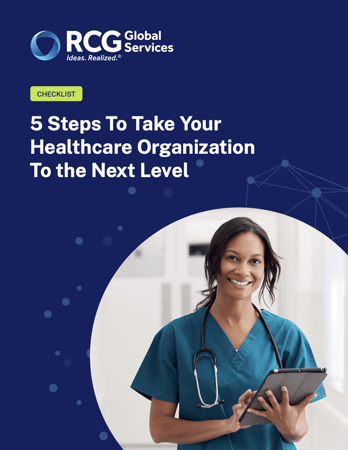5 Steps To Take Your Healthcare Organization To The Next Level
Download Our Guide to Future-Ready Healthcare

Elements of Innovative Healthcare Organizations

Customers and patients have a unique relationship with their healthcare providers, payors, and other healthcare professionals, because nothing is as sensitive or personal as one’s health. At the core of that relationship is trust.
But that doesn’t make the healthcare industry immune to the rapidly changing digital trends that are shaping many others—including expectations about how, when, and where patients, members, and customers interact and communicate with the organizations that provide their products and services.
That’s why it is as important as ever for health care organizations (HCOs) to know the tools, changes, and solutions they can introduce today to be ready to meet evolving customer expectations in a way that engenders and fosters trust and easy interactions.
How can HCOs prioritize their digital transformation investments and programs and what steps should they take to take advantage of what the many aspects of digital transformation have to offer?
Let’s dive in.
The Importance of Digital Transformation in Healthcare

It is no surprise that digital transformation in healthcare can introduce solutions, tools and enabling technologies that not only improve the quality and accessibility of healthcare services, but also allow HCOs to do more with less but at higher quality regardless of their role in the healthcare ecosystem.
By leveraging digital technologies such as cloud-enabled applications, services and computer power, AI, intelligent automation, advanced analytics, and telehealth together with health and operations data, core electronic medical records, enterprise resources, and other core systems, the entire healthcare ecosystem can:
- More efficiently and effectively diagnose and treat patients, leading to better health outcomes and reduced costs.
- Lean in on proactive and preventive health to keep people and populations more healthy.
- Enhance patient engagement, experience, and empowerment by enabling them and their caregivers to take a more active role in managing their health.
- Harness direct and indirect patient and provider data to facilitate healthcare innovators and solution providers to identify insights and continue the drive toward more personalized medicine.
- Augment and enhance the role of the overtaxed healthcare workforce amid a tremendous shortage of clinicians and talented workers.
- Remove burdensome cost and friction in the overall system to make the most of precious resources in the ongoing pursuit of value-based care.
Lastly, investments in digital transformation can allow HCOs to step back and holistically view and enhance the entire customer-patient-member-workforce experience. Taking this broader, comprehensive perspective across the stakeholder chain can help highlight and accelerate opportunities for collaboration to streamline processes, improve data sharing, manage hand-offs, and address problems in a more real-time manner. This is essential to create a more responsive and agile industry with more intelligent, data-enabled, and personalized journeys for healthcare workers, customers, and suppliers alike.
5 Steps To Take Your Healthcare Organization to the Next Level

Shifting from today’s healthcare experience to one that is full off with new opportunities, efficient processes, and personalized services requires strategic commitment and stamina. Successful, progressive HCOs will benefit greatly by following a proven path to proactively shift toward a digital-first posture in their process, technology and engagement operations. Yet the driving force behind any digital program remains a key and critical focus on patients, members, customers, and healthcare workers.
Along that journey, organizations can use these five elements as trusted waypoints.
1. Create an Actionable Digital Strategy To Introduce and Scale Technology, Data, and Operations
No journey should begin without a roadmap that brings together the values, goals, constraints, and checkpoints that will define it. This is exactly what a digital strategy can do for your HCO.
As a first step, organizations should bring together internal and external stakeholders to secure alignment and commitment, as well as set clear and high-caliber ambitions, targets, and plans to create business architecture and impact that delivers results over the long-haul. This includes:
- A current-state snapshot of the processes, technology, and customer touchpoints that define your current operating model.
- Digital tools and solutions that better rationalize, integrate, streamline operations, and breakdown data and functional silos.
- Methods to engage and communicate with leadership and key enablers throughout your organization to ensure the right resources are made available to enable success and make timely decisions.
- Metrics and required data sources that allow for progress to be measured in alignment with key strategic programs.
- How refinements and updates can be made over time as new best practices are introduced.
In addition to these steps, a digital strategy should stand upon a strong foundation that prioritizes:
- Alignment with upcoming changes in regulations, such as price transparency regulations and state-level reforms
- Compliance with strict healthcare regulations, particularly in regards to patient data privacy, quality of care, and security.
Assuring that the business architecture delivers value as an effective communication and analytical framework for translating strategy into actionable initiatives is essential to driving transformational change, navigating complexity, reducing risk, making informed decisions, aligning diverse stakeholders to a shared vision of the future, and leveraging technology more effectively.
2. Harness the Power of Data
On average, individuals create 1.7MB of data every second. Without the right planning, tools, training, and support, HCOs will have trouble building momentum for meaningful change. This is particularly the case when it comes to dealing with the fuel that drives sentience in any organization: data.
By consolidating data from across your organization, your team, extended partnerships, and collaborators will be able to more effectively personalize patient, member, and customer experiences, drive better outcomes, and identify potential operational inefficiencies using data-driven analysis.
To enable your organization to harness the data that is already flowing through your operations, focus on:
- Enabling data ingestion and integration to address the challenge of disparate, untrusted data.
- Processing data at the right speed for supporting business requirements and objectives, particularly around customer experiences, journeys, and critical processes.
- Unifying and enriching customer-patient-member data with related sources to provide more context.
- Leveraging machine learning, artificial intelligence, and advanced analytics to model, analyze, and extrapolate data into actionable recommendations.
Building intelligent business solutions with modern data architectures, AI, and advanced analytics is key to modern digital business platforms that are increasingly intelligent, predictive, and real-time. Data focus is essential to accelerate time to market, reduce costs, support sustainable growth, and become increasingly sentient and resilient to have better overall outcomes in the healthcare ecosystem.
3. Empower Internal and External Stakeholders About the Role, Benefits and Impact of Digital Change
Successful organizations understand that digitally transforming and re-platforming an organization involves a tremendous change in management—which requires as much if not more focus as the actual technology change itself. The organization will look and feel very different once it begins to embrace a digital transformation mindset, as there are paradigm shifts in thinking, collaboration, and what is now possible.
While many exciting elements will come with this change, there will also be some points of friction that can dampen the positive impact. It is important that stakeholders feel part of and excited about any change. Change often brings fear, underestimation, and doubt despite also bringing an exuberance, enthusiasm and anticipation of what is to come. It is vital to acknowledge and empower your internal and external stakeholders with the communications and tools they need to be a part of the change—and to give this aspect of your transformation lots of attention and support.
Some best practices to create a responsive digital transformation program include:
- Encouraging, soliciting, and engaging with input and using it to shape the future vision.
- Clarifying who your major stakeholders are and what they need most from a digital transformation, as well as creating a stakeholder map.
- Communicating the “why” behind reshaping processes and introducing technology that will create efficiencies, break down silos, and foster innovation.
- Embedding core values of your organization into potential changes. This often also includes updating or adding certain core values appropriate to the vision of a digital-focused, sentient organization.
- Investing in employee growth, training, and management support in ways that resonate with their needs and work styles.
- Promoting wins, gains, and sharing how outcomes are consistently monitored by key metrics.
- Creating lots of white space, opportunity for big dialogue, and assuring that stakeholders are able to express their ideas, concerns, and enthusiasm.
- Celebrated wins of all kinds. Positive momentum is a superpower in large organizational transformations.
- Strong united leadership communication that keeps in mind that hope is a force multiplier. Leaders need to help keep the organization’s eye on the vision and prize—especially when teams are deep in the details and technical issues that must be accomplished.
4. Learn From Peers and Other Industry Best Practices
Innovation happens in every industry, every day. As Peter Drucker famously said, “innovate or die.” The books are filled with examples of organizations that failed to innovate and change. Part of building innovation muscle is to make it a priority to look outside of the healthcare industry to identify new ways to provide responsive and personalized services. In years past, this was a foreign concept in healthcare; you have probably heard the old saying that “healthcare is different.”
Thanks to the quality movement, that attitude has greatly changed. Today, the most innovative organizations actively seek out cross-industry pollination with talent and practices. For example, leaders in retail and hospitality are constantly innovating, measuring, and refining their customer service models—online and in-person—to build loyalty and engagement. Successful health systems, payors, and other industry players today are adapting key areas of success such as journey management, omnichannel experience, segmentation, and more.
A digital strategy should be more than a document; it should be a dynamic collaborative process and organizational framework that grows, adapts, and evolves with your organization. Look for opportunities to refine its vision by:
- Looking beyond your typical networks and peers to see what organizations in and out of your industry are doing to drive engagement, embrace digital transformation, and remain agile.
- Staying informed with latest best practices in customer experience, data management, cloud strategy, and more.
- Understanding competitors’ or peers’ initiatives experiences and lessons learned and comparing them with the outcomes their initiatives have achieved.
5. Lean on a Trusted Partner
When it comes to a sustainable, successful digital transformation program, there is no shortcut to success.
However, making the decision to engage a partner can accelerate and amplify your organization’s investment in its future. Few organizations are able to go it alone. Successful organizations seek out partners who can become trusted advisors and strategic partners co-invested in success now and in the long-term.
While there are unique technical elements to every engagement, these criteria should be on your partner’s must-have list:
- An understanding of and experience with the human element that drives and shapes digital transformation.
- A true respect and passion for the values and business drivers that shape your operations.
- A deep resume of experience, thought leadership, frameworks, and accelerators to implement digital tools that help your healthcare organization scale.
- A willingness to roll up their sleeves and find the root cause of a problem—not just to address symptoms in search of short-lived success.
- A commitment to being truthful and honest in what makes sense for your organization’s priority agenda.
- A willingness to commit to a dynamic, flexible, outcome-focused strategic relationship.
Bring Life to Your Digital Transformation Strategy With RCG

No matter where your organization is in its digital transformation journey, having a partner like RCG Global Services with the experience, specific expertise, passion, and strategic commitment to support your organization through the ups and downs of change can help your team not only make the most of your investment but also make it a fun and rewarding journey.
Between finding the right technology and tools, delivering end-to-end implementation support, and connecting your team with proven approaches and digital-first capabilities that keep your organization at the competitive edge, RCG knows what it means to serve members of the healthcare ecosystem.
Ready to learn more about how RCG can help your organization deliver the experiences your patients, members, or customers expect and deserve? Then click here to set-up your own personalized meeting with an RCG expert.
And if you want your own copy of this resource to easily share with your team, fill out the form below
Download a PDF version of this guide by filling out this form

